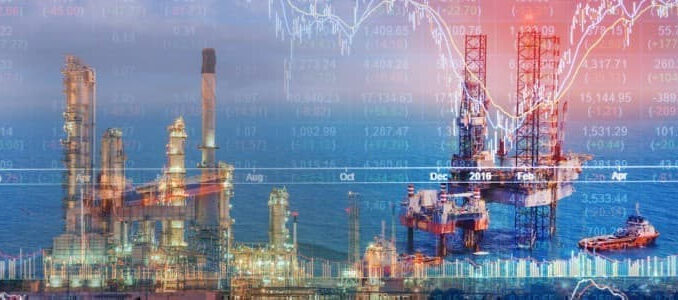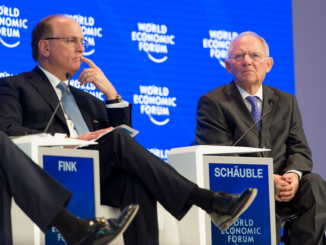
It was supposed to be a blockbuster quarter for energy names thanks to the ongoing surge in oil prices and it did not disappoint: earlier today Chevron reported stellar Q3 earnings, beating on the top and bottom line, with EPS of $2.96 (beating expectations of $2.21), the highest since Q1 2013 on improved market conditions, leading the energy giant to weigh more share buybacks while reining in spending after surging natural gas prices and oil-refining returns drove the U.S. supermajor’s free cash flow to an all-time high. Then moments ago, Exxon Mobil also posted its biggest profit in seven years with Free Cash Flow beating estimates and surprisingly pledging to spend as much as $10 billion on share buybacks over the next 12-24 months.
Looking at the press release, Exxon earned an adjusted $1.58 a share during the third quarter, just above the $1.56 average estimate while adjusted net income reached $6.8 billion, the most since 2014. One year ago, the company lost $650 million amid crashing oil prices.
Here is what Exxon reported for Q3:
- Adjusted EPS $1.58, beating the estimate $1.56 (GAAP EPS $1.57 vs. loss/share 15.00c y/y).
- Upstream earnings $3.95 billion vs. loss $383.0 million y/y, missing the estimate $4.47 billion
- Downstream earnings $1.26 billion vs. loss $231.0 million y/y, beating the estimate $830.1 million
- Chemical earnings $2.14 billion vs. $661 million y/y, beating the estimate $2.11 billion
- Chemical prime product sales 6,672 kt, +0.7% y/y
- Downstream petroleum product sales 5,327 kbd, +6.1% y/y
- Refinery throughput 4,051 mb/d, +7.8% y/y
Q3 highlights:

Comparing Q3 to Q2 earnings, the company highlighted a $2.1 billion improvement in earnings:

Production:
- Production 3,665 mboe/d, -0.2% y/y, estimate 3,644
- Production 8,110 mmcfe/d, -2.5% y/y, estimate 8,345
Cash Flow:
- Cash flow from operations $12.09 billion vs. $4.39 billion y/y, beating the estimate $11.22 billion
- Cash flow from operations and asset sales $12.11 billion vs. $4.49 billion y/y
In terms of cash use, the company spent $3.1BN on PP&E, with the balance spent on debt paydowns ($3.8BN) as the company continued to strengthen its balance sheet, and dividends ($3.7BN , bringing the YTD total to $11.2BN).

CapEx:
- Capital expenditure $3.85 billion, -6.8% y/y, estimate $3.82 billion (range $3.47 billion to $4.50 billion)
A visual summary:
As shown in the following Y/Y bridge, a majority of the gains from Q3 2020 came from Upstream price increases, with chemical and downstream margin improvements contributing the balance:

Commentary and context:
- On Track to Achieve ’25 Emission-Reduction Plan by Yr End
- Sees 4x Increase in Low-Carbon Spend
- Sees Higher Upstream Volumes in 4Q
- “All three of our core businesses generated positive earnings during the quarter, with strong operations and cost control, as well as increased realizations and improved demand for fuels,” said Darren Woods, chairman and chief executive officer
- Woords: “Next month, the board will finalize our corporate plan that supports investment in industry-advantaged, high-return projects, and a growing list of strategic and financially accretive lower-carbon business opportunities… expect to increase the level of spend in lower-emission energy solutions by four times over the prior plan, adding projects with strong returns as well as seeding some development investment in large hub projects that require further policy support.”
- 2021 capital program expected to be near low end of $16 billion to $19 billion range, so no immediate surge in capital spending which will mean continued high prices as US supply fails to rebound.
- In 4Q, board will formally approve corporate plan, with capital spending expected in range of $20 billion to $25 billion annually
- Exxon expects cumulative low- carbon investments to be about $15 billion from 2022 through 2027
- Sees higher energy costs impacting Europe & Asia refined- product prices in 4Q
But perhaps what was the most surprising aspect of Exxon’s release is the company’s revival stock buybacks repurchases for the first time since 2016. The company said it plans to spend as much as $10 billion on repurchases starting next year.
Following a surge in activist investor interest, Exxon and Chevron – the two largest U.S. oil and gas producers – are finally prioritizing shareholders rather than capital spending, despite energy crises in Europe and China and widespread concern about inflation and supplies of fossil fuels. The crucial question for executives at both companies when they appear on their respective conference calls with analysts later on Friday will be whether some of additional cash goes into boosting crude and gas production in 2022.
Exxon is expected to use the bulk of its extra cash flow to cover dividends and pay down debt, which peaked on a net basis at almost $70 billion at the end of 2020. All four of the company’s major rivals – Chevron, TotalEnergies SE, Royal Dutch Shell Plc and BP Plc – are using this year’s commodity rally to buy back shares as well. Shell and BP were forced to cut their dividends last year.
A big reason why both Exxon and Chevron oil generating record cash flow is because of deep budget cuts made during the pandemic-driven oil-market collapse of last year. Chevron’s year-to-date spending was 22% lower than the year-earlier period. But with record natural gas prices in Europe and Asia, and robust crude prices everywhere, there are growing incentives to increase investments in fossil fuels.
Looking ahead, the company gave an optimistic preview of the fourth quarter, expecting solid improvement across its 3 key segments, as well as continued corporate “streamlining”

And assuming $60 oil, the company expects earnings to hit $30BN by 2025, nearly triple the 2019 level, with cost-reductions expected to exceed $6BN by 2023 vs 2019.

Finally, with US oil E&Ps under the microscope of the net zero lobby, the company pledged $15BN in lower carbon investments from 2022 to 2027. Needless to say, this money is taken away from expanding its legacy business which is why the price of commodities will keep rising.

Following the solid earnings, and the surprise $10BN buyback announcement, the stock price jumped in the pre-market rising to its June highs, and is likely to continue its ascent higher as XOM’s average rating is ‘Hold’, and the average sellside target price is just $68.52. Expect a burst of upgrades in the coming days.

By Tom Kool for Oilprice.com




